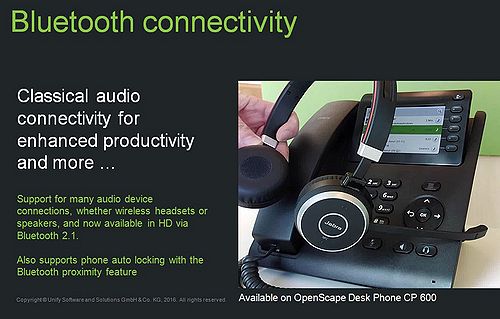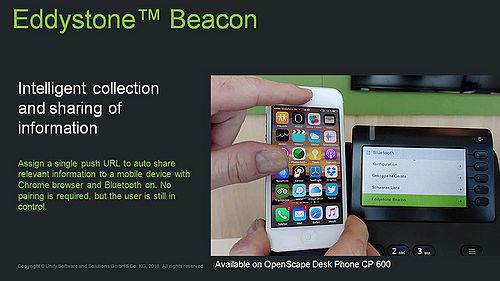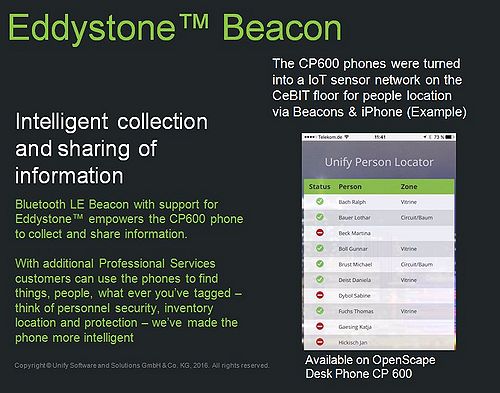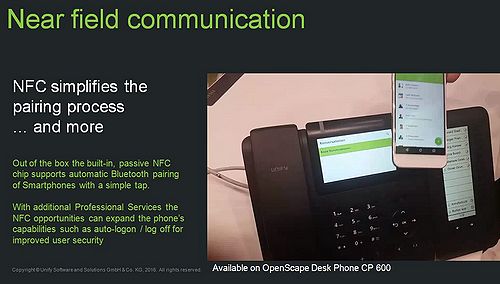Difference between revisions of "OpenScape Desk Phone CP FAQ"
The Wiki of Unify contains information on clients and devices, communications systems and unified communications. - Unify GmbH & Co. KG is a Trademark Licensee of Siemens AG.
| Line 16: | Line 16: | ||
The OpenScape Desk Phone CP600 phone supports in addition to the "classical" [[Bluetooth]] Specification also the new [[Bluetooth]] Specification 4.1 <br /> | The OpenScape Desk Phone CP600 phone supports in addition to the "classical" [[Bluetooth]] Specification also the new [[Bluetooth]] Specification 4.1 <br /> | ||
One of the new prominent feature is the [[Bluetooth]] Proximity Profile (PXP). | One of the new prominent feature is the [[Bluetooth]] Proximity Profile (PXP). | ||
| − | The Proximity Profile defines the behavior of the OpenScape Desk Phone | + | The Proximity Profile defines the behavior of the OpenScape Desk Phone CP600 when a [[Bluetooth]] 4.1 device moves away or come closer together. |
For example, when workers approach their desks, the OpenScape Desk Phone CP600 phone detects proximity of their [[Bluetooth]] 4.1 supported headsets or mobile devices and automatically logs them in into the OpenScape Desk Phone CP600. Access to the phone and personal data can be protected in a comfortable and intuitive manner - smart and simple. <br /> | For example, when workers approach their desks, the OpenScape Desk Phone CP600 phone detects proximity of their [[Bluetooth]] 4.1 supported headsets or mobile devices and automatically logs them in into the OpenScape Desk Phone CP600. Access to the phone and personal data can be protected in a comfortable and intuitive manner - smart and simple. <br /> | ||
Now workers are able to use a phone no matter at which desks they sit. This is ideal for organizations that have a high number of transient or temporary employees, and it works with the hoteling model. | Now workers are able to use a phone no matter at which desks they sit. This is ideal for organizations that have a high number of transient or temporary employees, and it works with the hoteling model. | ||
=== Eddystone beacon === | === Eddystone beacon === | ||
| − | Eddystone beacon is a technology provided by Google | + | Eddystone beacon is a technology provided by Google and is supported in the OpenScape Desk Phone CP600. <br /> |
The Eddystone beacon is part of the Physical Web initiative, which is about better connecting the real with the virtual world. The basic idea is to fully replicate the real world in the Internet. The challenge is to make all this information accessible in the moment where those are needed. | The Eddystone beacon is part of the Physical Web initiative, which is about better connecting the real with the virtual world. The basic idea is to fully replicate the real world in the Internet. The challenge is to make all this information accessible in the moment where those are needed. | ||
| − | Beacons are becoming increasingly popular to meet these requirements but can be difficult to manage and maintain, as they require periodic maintenance like changing batteries or updating firmware. Integrating Beacon technology into the desk phones and so with integration into the Enterprise network can increase the number of | + | Beacons are becoming increasingly popular to meet these requirements but can be difficult to manage and maintain, as they require periodic maintenance like changing batteries or updating firmware. Integrating Beacon technology into the desk phones and so with integration into the Enterprise network can increase the number of Beacons without having to deploy standalone ones or to care about batteries. |
| − | Those Beacons have become popular in tracking customers, devices, or workers, and enable companies to push information to users automatically. To realize those functionalities, the new Eddystone | + | Those Beacons have become popular in tracking customers, devices, or workers, and enable companies to push information to users automatically. To realize those functionalities, the new Eddystone Beacon support two basic use cases: <br /> |
1) The OpenScape Desk Phone CP600 transmit Eddystone-URL frames <br /> | 1) The OpenScape Desk Phone CP600 transmit Eddystone-URL frames <br /> | ||
| Line 34: | Line 34: | ||
2) The OpenScape Desk Phone receives Eddystone frames <br /> | 2) The OpenScape Desk Phone receives Eddystone frames <br /> | ||
| − | Consider an enterprise that uses Bluetooth-enabled mobile devices (e.g. expensive/to be shared mobile heart rate monitor with attached [[Bluetooth]] 4.1 sender). This enterprise could use the OpenScape Desk Phone CP600 phones to span a wireless network to track those devices, creating an application to show the exact location of each device to find them fast and simply. The same could be done with humans when they carry Bluetooth 4.1. sender. | + | Consider an enterprise that uses Bluetooth-enabled mobile devices (e.g. hospital with expensive/to be shared mobile heart rate monitor with attached [[Bluetooth]] 4.1 sender). This enterprise could use the OpenScape Desk Phone CP600 phones to span a wireless network to track those devices, creating an application to show the exact location of each device to find them fast and simply. The same could be done with humans when they carry Bluetooth 4.1. sender. We used for instance at last CEBIT fair the OpenScape Desk Phone CP 600 on the exhibition both to locate the booth duties. |
There are many other use cases for this, ranging from Internet of Things (IoT) applications to security. | There are many other use cases for this, ranging from Internet of Things (IoT) applications to security. | ||
Remarks to realization: <br /> | Remarks to realization: <br /> | ||
| − | Bluetooth devices which would use this service (e.g. smartphones) don´t need a classical [[Bluetooth]] pairing. Each Smartphone equipped with [[Bluetooth]] 4. | + | Bluetooth devices which would use this service (e.g. smartphones) don´t need a classical [[Bluetooth]] pairing. Each Smartphone equipped with [[Bluetooth]] 4.1 Low Energy and a newer version of the Chrome browser is able to read and display those URLs. |
[[Image:Edystone use case (2).JPG|rigth|500px]] | [[Image:Edystone use case (2).JPG|rigth|500px]] | ||
| Line 45: | Line 45: | ||
=== Near Field Communication (NFC) === | === Near Field Communication (NFC) === | ||
NFC support makes the process of pairing a smartphone to the OpenScape Desk Phone CP600 simple, requiring just a single tap - no manual pairing via menus and entering a PIN. | NFC support makes the process of pairing a smartphone to the OpenScape Desk Phone CP600 simple, requiring just a single tap - no manual pairing via menus and entering a PIN. | ||
| − | The Desk Phone CP600 supports that Secure Simple Pairing with smartphones, but not headsets, as these usually | + | The OpenScape Desk Phone CP600 supports that Secure Simple Pairing with smartphones, but not headsets, as these usually carry a NFC tag. |
Remarks to realization: <br /> | Remarks to realization: <br /> | ||
Revision as of 10:58, 22 June 2016
In this OpenScape Desk Phone CP FAQ you will find answers to frequently asked questions on the OpenScape Desk Phone CP phone family, divided into various topics.
Contents
Advanced Features
Bluetooth
With the OpenScape Desk Phone CP600 phone is Bluetooth available and allows use of Bluetooth headsets. More interesting features are supported using Bluetooth: Proximity Monitoring and Eddystone Beacons.
Audio Scenario, for Bluetooth Headset connection
The so called “classical” Bluetooth Specification 2.1 provides connectivity for a wide range of audio devices, including headsets and hands-free units. Support for high-definition audio devices is new in the OpenScape Desk Phone CP600.
Proximity Detection
The OpenScape Desk Phone CP600 phone supports in addition to the "classical" Bluetooth Specification also the new Bluetooth Specification 4.1
One of the new prominent feature is the Bluetooth Proximity Profile (PXP).
The Proximity Profile defines the behavior of the OpenScape Desk Phone CP600 when a Bluetooth 4.1 device moves away or come closer together.
For example, when workers approach their desks, the OpenScape Desk Phone CP600 phone detects proximity of their Bluetooth 4.1 supported headsets or mobile devices and automatically logs them in into the OpenScape Desk Phone CP600. Access to the phone and personal data can be protected in a comfortable and intuitive manner - smart and simple.
Now workers are able to use a phone no matter at which desks they sit. This is ideal for organizations that have a high number of transient or temporary employees, and it works with the hoteling model.
Eddystone beacon
Eddystone beacon is a technology provided by Google and is supported in the OpenScape Desk Phone CP600.
The Eddystone beacon is part of the Physical Web initiative, which is about better connecting the real with the virtual world. The basic idea is to fully replicate the real world in the Internet. The challenge is to make all this information accessible in the moment where those are needed.
Beacons are becoming increasingly popular to meet these requirements but can be difficult to manage and maintain, as they require periodic maintenance like changing batteries or updating firmware. Integrating Beacon technology into the desk phones and so with integration into the Enterprise network can increase the number of Beacons without having to deploy standalone ones or to care about batteries.
Those Beacons have become popular in tracking customers, devices, or workers, and enable companies to push information to users automatically. To realize those functionalities, the new Eddystone Beacon support two basic use cases:
1) The OpenScape Desk Phone CP600 transmit Eddystone-URL frames
The OpenScape Desk Phone CP600 provide access to Location Based Services to mobile user. That Location Based Services are services which are relevant at a specific place, for instance pushing advertising and special rates/deal of the day in a shop; providing menu/lunch cards to the workers or simply send access to instruction to the phone.
2) The OpenScape Desk Phone receives Eddystone frames
Consider an enterprise that uses Bluetooth-enabled mobile devices (e.g. hospital with expensive/to be shared mobile heart rate monitor with attached Bluetooth 4.1 sender). This enterprise could use the OpenScape Desk Phone CP600 phones to span a wireless network to track those devices, creating an application to show the exact location of each device to find them fast and simply. The same could be done with humans when they carry Bluetooth 4.1. sender. We used for instance at last CEBIT fair the OpenScape Desk Phone CP 600 on the exhibition both to locate the booth duties.
There are many other use cases for this, ranging from Internet of Things (IoT) applications to security.
Remarks to realization:
Bluetooth devices which would use this service (e.g. smartphones) don´t need a classical Bluetooth pairing. Each Smartphone equipped with Bluetooth 4.1 Low Energy and a newer version of the Chrome browser is able to read and display those URLs.
Near Field Communication (NFC)
NFC support makes the process of pairing a smartphone to the OpenScape Desk Phone CP600 simple, requiring just a single tap - no manual pairing via menus and entering a PIN. The OpenScape Desk Phone CP600 supports that Secure Simple Pairing with smartphones, but not headsets, as these usually carry a NFC tag.
Remarks to realization:
The NFC tag in the OpenScape Desk Phone CP600 is read-only and contains the MAC address of the OpenScape Desk Phone CP600 and the built-in Bluetooth chip.
With an additional implementation / service this technology can also be used to automatically login mobile users on OpenScape Desk Phone CP600. An Android application just needs to read the data from the NFC tag and send this together with the user’s E.164 number to the Management Server. This is all the Management Server needs to know to send the user’s personal data to the visited OpenScape Desk Phone CP600. That use cases can be realized with support of the UNIFY Professional Service.
More information:
Blog from BeaconZone to the OpenScape Desk Phone CP
https://www.beaconzone.co.uk/blog/ip-telephone-with-eddystone/
Talk with Scott Jenson about the Physical Web
https://www.youtube.com/watch?v=w8zkLGwzP_4
Background info on what the concept of "Physical Web" is about
https://google.github.io/physical-web/
More information to the concept of Eddystone
https://github.com/google/eddystone








